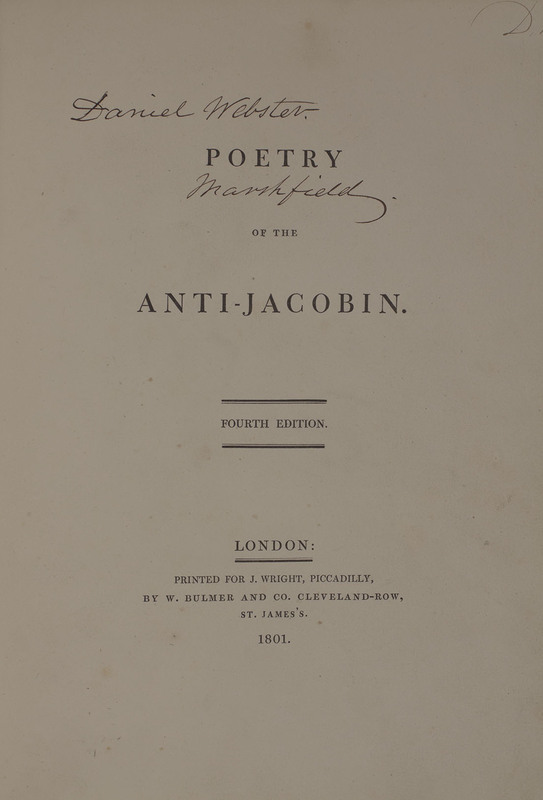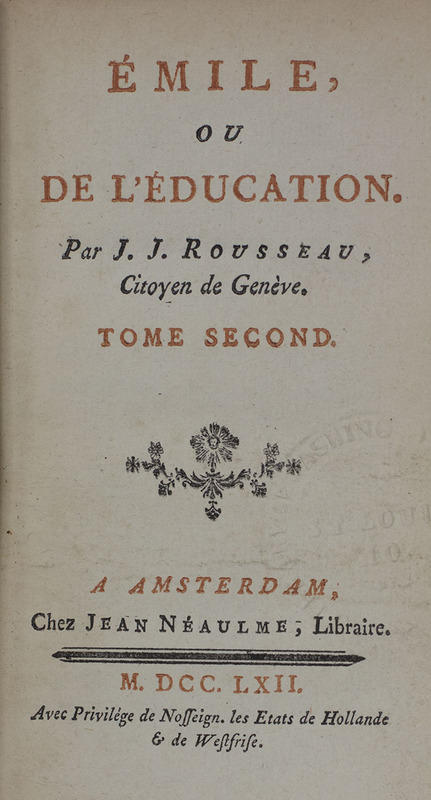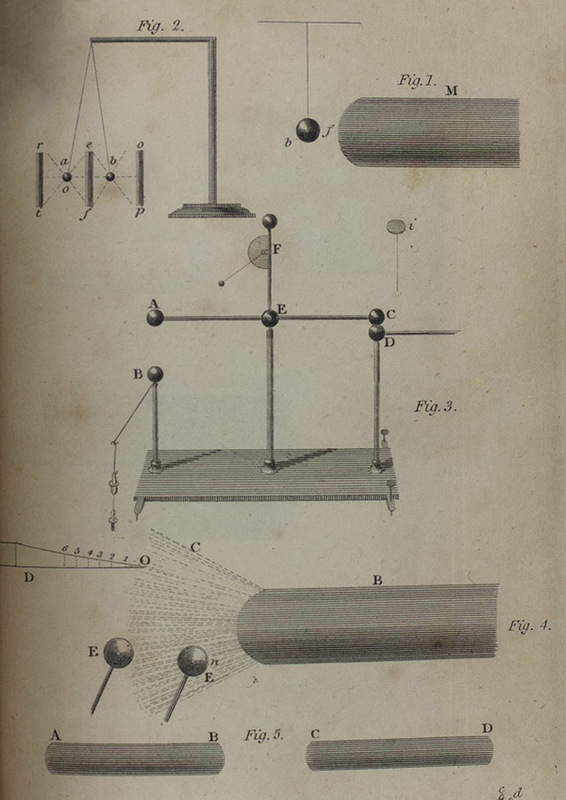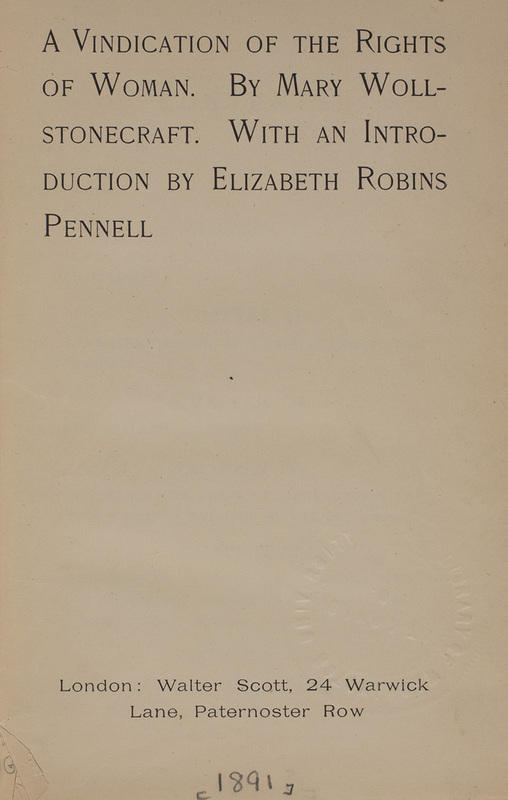The Author's Library
A prolific reader, Mary Shelley encountered the ideas represented in these texts before publishing Frankenstein in 1818. The author’s library includes galvanic texts; works written by and about her radical family members; and classic works of poetry, philosophy, and literature. Shelley incorporated these works to various degrees, directly quoting some while touching upon the philosophies of others. These works informed Shelley’s writing and concurrently provide historical and literary context for the novel.
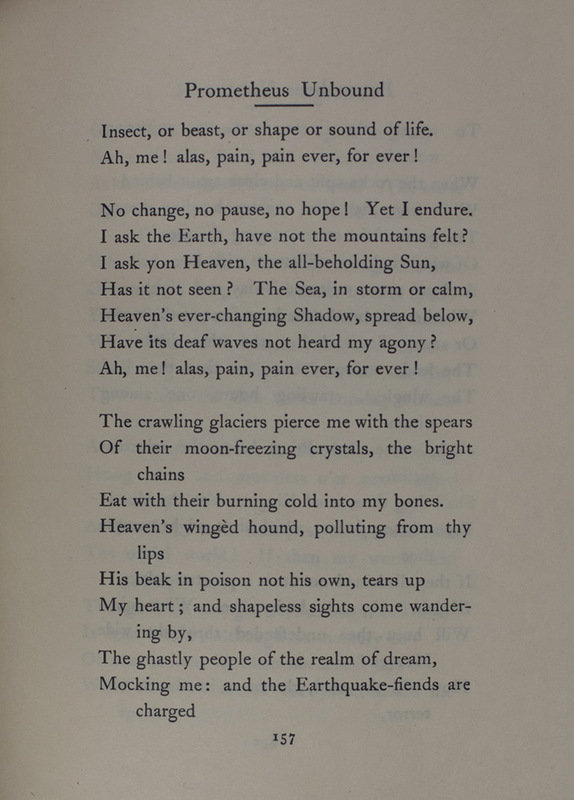
Percy Bysshe Shelley, Prometheus Unbound, vol. 3 in The Complete Works of Percy Bysshe Shelley, ed. Nathan Haskell Dole (London: Virtue & Company, 1905)
Prometheus Unbound
Percy Shelley
Percy Bysshe Shelley, Prometheus Unbound, vol. 3 in The Complete Works of Percy Bysshe Shelley, ed. Nathan Haskell Dole (London: Virtue & Company, 1905)
Percy Bysshe Shelley’s Prometheus Unbound is a lyrical drama based on the Greek myth of Prometheus, a trickster Titan who steals fire from Mount Olympus and is sentenced by Jupiter to eternal torment. While Shelley’s work does not reconcile the enemies, as does the Greek tragedian Aeschylus, Prometheus learns to pity and forgive Jupiter; his freedom, however, is contingent upon Jupiter’s fall from power. Shelley published his drama in 1820; Mary Shelley, P. Shelley’s wife and author of Frankenstein, or the Modern Prometheus, published her novel two years prior. The two works are strongly connected through theme and title, no doubt due to overlapping writing and conceptualization of the spouses. Like Prometheus, Victor Frankenstein uncovers forbidden knowledge — sacred fire for the former, and the secret of creation for the latter — and pays dearly for his actions. Motifs of scientific enlightenment, divinity, responsibility, and revenge abound. On the selected page, Prometheus despairs and defies in the same breath, exclaiming, “No change, no pause, no hope! Yet I endure.” Already long-suffering in the opening of Shelley’s drama, Prometheus still scorns Jupiter as a tyrant and then, despite his own anguish, vows to “hate no more.” It is a brief but stunning character development, and one that is mirrored but not fully reflected in Frankenstein. In Prometheus, we see the agonized loneliness and rebellion of Frankenstein’s creature — we may even see a foreshadowing of the creature’s reconciliation with his dead creator — but we also see the audacity and eventual destruction of Frankenstein himself.
-Julia Kim
Poetry of the Anti-Jacobin
Poetry of the Anti-Jacobin is a selection of poems drawn from the British satirical newspaper The Anti-Jacobin. The Anti-Jacobin ran from mid-1797 to mid-1798, and in 1799 Poetry of the Anti-Jacobin was published due to the newspaper’s lingering popularity. At the time, British conservatives condemned all radical opinions as “Jacobin,” referring to the club of revolutionaries who instituted the Reign of Terror in France. The Anti-Jacobin targeted supporters of the French Revolution, making fun of a wide range of radical public figures. Among these were Mary Shelley’s parents, William Godwin and Mary Wollstonecraft. Although Godwin and Wollstonecraft were well-respected writers, their work inspired harsh opposition from conservatives. For example, more than one edition of The Anti-Jacobin describes Wollstonecraft as a prostitute. However, criticism of Shelley’s parents did not make it into the final selection of works in Poetry of the Anti-Jacobin. Instead, contained here is a characteristic satirical poem. The writer (a conservative) adopts the role of “a Jacobin,” writing this ode to the invented goddess Anarchy in Horace’s elevated style. Shelley read Poetry of the Anti-Jacobin in 1817, just one year before writing Frankenstein. The work was one of many critiques of her parents she read, suggesting that she was well aware of the backlash that the print world can create. Furthermore, the breadth of Shelley knowledge is evident: by reading both her parents’ texts and opposition to their ideas, she was equipped with a broad range of perspectives to tackle the complex ethical questions raised in Frankenstein.
-Anna Lin-Schweitzer
Émile
Rousseau
Rousseau’s Émile: ou, De l’éducation is intended as a sort of instructional manual. Rousseau purports to outline how to raise and educate a young boy so that he will grow into the ideal man, or more specifically, how to retain his natural goodness while still participating in a corrupt society. Although it was officially banned by government censors, Émile managed to revolutionize educational practices in France. Rousseau’s emphasis on the importance of student-driven discovery served as a precursor to the Montessori school system, which remains popular today. This text is Tome II of a first edition 1762 copy which survived public burnings of the book that were held in both Paris and Geneva. One prominent opponent of Rousseau’s work was Mary Wollstonecraft, who denounced Rousseau’s treatment of women as a secondary class of citizen. Mary Shelley would have been familiar with both her mother’s response to Émile and read the text herself in 1815, three years before publishing Frankenstein. In her novel, Shelley modifies and expands upon Rousseau’s ideas. Unlike the eponymous Émile, Shelley’s Creature does not have a private tutor but is instead abandoned by his creator. Left to independently confront an immoral society, the Creature is repulsed by everyone he meets. The hostility and isolation that the Creature encounters corrupts any sense he had of natural morality and lead him to commit several violent acts. As Rousseau had predicted, a “child” without proper guidance and education would be corrupted by contemporary society.
-Anne Seul
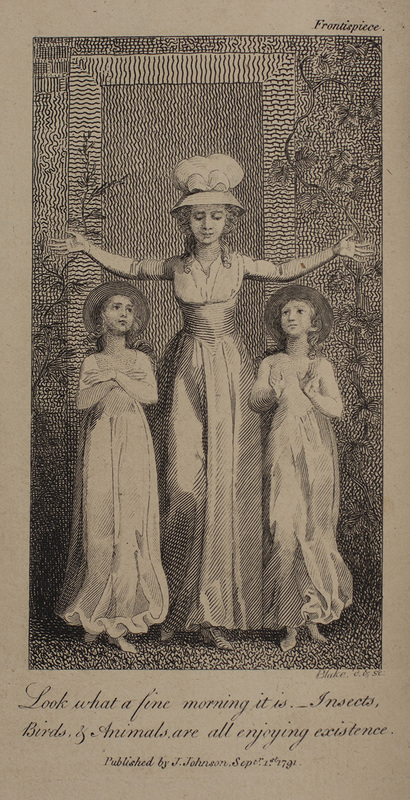
Mary Wollstonecraft, Original Stories from Real Life, illus. William Blake (London: J. Johnson, 1791)
Original Stories from Real Life
Wollstonecraft
Published in 1791, the illustrated edition of Mary Wollstonecraft’s Original Stories from Real Life promotes the education of women. In one scholar’s words, as an outspoken feminist, Wollstonecraft’s aim in writing the book was to “make up for some of the parental neglect in her society.” Original Stories follows instructor Mrs. Mason, as she takes on a maternal role for Mary and Caroline, two orphaned students. In one instance, Mrs. Mason tells Mary, “Do all the good you can the present day, nay hour, if you would keep your conscience clear.” Original Stories reflects a somewhat pessimistic view of the world, and this is evident in William Blake’s illustrations. The engravings are gloomy, and the characters rarely smile. Mrs. Mason describes her life as “very unfortunate,” perhaps indicating to readers that women of Wollstonecraft’s society are systematically oppressed. Nonetheless, Mrs. Mason and Wollstonecraft work to help their students realize their potential. Shelley was undoubtedly exposed to her mother’s book, and its themes of feminism, education, motherhood, and sensibility likely inform Frankenstein. The books, both initially published anonymously, share a pessimistic view of the world. Yet, they subtly indicate that educated women could be the answer to a corrupted society.
-Joshua Leopold
Elements of Galvanism
Wilkinson
Charles Henry Wilkinson’s Elements of Galvanism is a two-volume treatise on galvanism, describing both its history and practical directions for performing galvanic experiments. C.H. Wilkinson was a lecturer on galvanism and member of the Royal College of Surgeons, as well of a number of other philosophical and medical societies. The first volume of the text deals primarily with the history of galvanism, describing the experiments and theories of galvanists including Galvani, M. Valli, and Aldini, among others. The galvanic experiments Wilkinson describes range from making frog legs twitch to inducing movement in a human corpse, and he discusses how those experiments led to various theories about animals, plants, and electricity. In the second volume, Wilkinson provides instructions on how to perform galvanic experiments in the service of a number of different disciplines, including anatomy and medicine. There are a number of copperplate illustrations at the back of the second volume showing galvanic instruments, experiments, and dissections. These illustrations are labeled as different figures so that they can be correlated to their mentions in the text, though they are all found at the back of the book. The author also discusses his own opinions about the uses and limits of galvanism in the text. Notably, Wilkinson expresses his belief that even with the aid of galvanism, humans do not possess the power to discover the source of life.
-Rachel Butler
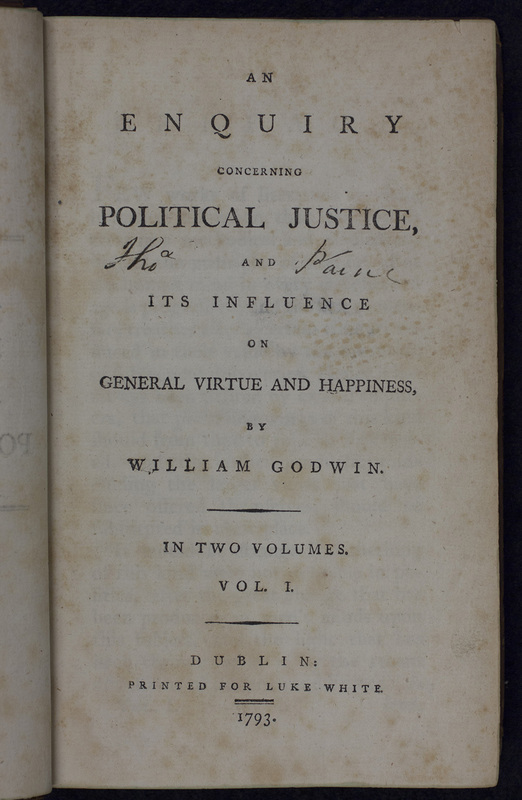
William Godwin, An Enquiry Concerning Political Justice, and Its Influence on General Virtue and Happiness (Dublin: L. White, 1793)
An Enquiry Concerning Political Justice
Godwin
During his lifetime, Mary Shelley’s father, William Godwin, was best known for his philosophical political beliefs. An Enquiry Concerning Political Justice was a radical text written in the wake of the French Revolution. First published in London in 1793, it established Godwin as a leader within radical political circles and became a major theoretical text for the English Jacobins. Enquiry was written in response to the conservative writings of Edmund Burke, who criticized the French Revolution, and in relation to Thomas Paine’s Rights of Man (1791). The page displayed is the title page of Paine’s copy with his signature — a visual reminder that Godwin was writing in conversation with other intellectuals of the time. In Enquiry, Godwin criticizes political institutions and supports anarchy. He asserts that government institutions are “monstrous” and argues that human progress, science, and reason will ameliorate the problems of the modern age and lead to a social rebirth for the human race. Critics often cite Godwin’s stance regarding “human perfectability” and his vision of the future as Enquiry’s most striking connections to Frankenstein. With “perfectability,” Godwin attempts to emphasize progressive social improvement, although the word itself is often misinterpreted. The idea, however, leads him to envision a future in which humans no longer reproduce sexually. Instead, men (Godwin does not mention women or children) will maintain human populations through social engineering. This notion represents a relatively brief moment in a two-volume text, but is often highlighted for its extremity as well as its relation to the themes of Frankenstein.
-Kristen Sze-Tu
A Vindication of the Rights of Woman
Wollstonecraft
In the second chapter of A Vindication, “The Prevailing Opinion of Sexual Character Discussed,” Mary Wollstonecraft examines women’s characters in relation to the role of education. Wollstonecraft critiques conventions that shape women to be “gentle,” “domestic,” and “innocent.” The part also links the quality of “innocence” to children, explaining that women should not be like children but independent individuals who use reason to achieve virtues. An ideal education should further women’s ability to use reason in pursuit of virtues. Wollstonecraft cites Paradise Lost to expose Milton’s inconsistencies, that some parts of his epic conflict with her argument, whereas some parts actually concur with her on it. Although Wollstonecraft passed away days after Mary Shelley’s birth, she continued to influence her as both a figure of mother whom Shelley adored and a philosopher whose writings were carefully studied by Shelley. The text displayed many interactions with Frankenstein in questions of gender and education. “Innocence,” for example, is central to the depictions of children and even figures of adults like Walton and Victor. Wollstonecraft’s interpretation of innocence as a gendered and undesired quality common among women complicates our readings of the presence of innocence in Frankenstein. The text with its critique of Milton also sheds light onto how Mary Shelley might potentially deviate from her literary predecessors whom Percy Shelley, her husband, claimed that she strove to follow and imitate.
-Yixin Huang

